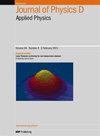考虑纳米级孔隙率对 PECVD 涂层中质量传输现象的影响
IF 3.2
3区 物理与天体物理
Q2 PHYSICS, APPLIED
引用次数: 0
摘要
在这里,我们展示了一种新方法来描述氧化硅(SiOx)涂层的气体传输行为并解释其基本动态。为此,我们在纳米尺度上对涂层进行了测量和模拟研究。正电子湮灭光谱(PAS)和基于量子力学电子结构的分子动力学模拟相结合,描述了氧化硅涂层的多孔结构。这种方法分析了直径小于 2 纳米的微孔对气体渗透的影响,而传统方法很难研究这些微孔。我们列出了主要的孔隙直径范围及其相关的孔隙率估计值。我们发现,层的生长对孔径和孔隙率有影响,层沉积过程中能量输入的增加会导致孔径变小和孔隙率降低。分子动力学模拟量化了氧气和水蒸气通过亲水和疏水系统的 PAS 扣除微孔范围的自扩散情况。理论孔隙大小范围与我们的 PAS 结果相匹配,并通过给出扩散系数来完善这些结果。通过这种方法,可以详细分析孔隙形态对薄膜涂层质量传输的影响,并鉴定其阻隔或膜性能。这是开发 PECVD 涂层中孔隙主导质量传输详尽模型的重要前提。本文章由计算机程序翻译,如有差异,请以英文原文为准。
Consideration of the effect of nanoscale porosity on mass transport phenomena in PECVD coatings
Here we show a novel approach to characterize the gas transfer behavior of silicon-oxide (SiOx) coatings and explain the underlying dynamics. For this, we investigate the coating on a nm-scale both by measurement and simulation. Positron annihilation spectroscopy (PAS) and quantum mechanical electronic structure-based molecular dynamics simulations are combined to characterize the porous landscape of SiOx coatings. This approach analyses the influence of micropores smaller than 2 nm in diameter on gas permeation which are difficult to study with conventional methods. We lay out the main pore diameter ranges and their associated porosity estimates. An influence of layer growth on pore size and porosity was found, with an increased energy input during layer deposition leading to smaller pore sizes and a reduced porosity. The molecular dynamics simulations quantify the self-diffusion of oxygen and water vapor through those PAS deducted micropore ranges for hydrophilic and hydrophobic systems. The theoretical pore size ranges are fitting to our PAS results and complete them by giving diffusion coefficients. This approach enables detailed analysis of pore morphology on mass transport through thin film coatings and characterization of their barrier or membrane performance. This is a crucial prerequisite for the development of an exhaustive model of pore dominated mass transports in PECVD coatings.
求助全文
通过发布文献求助,成功后即可免费获取论文全文。
去求助
来源期刊
CiteScore
6.80
自引率
8.80%
发文量
835
审稿时长
2.1 months
期刊介绍:
This journal is concerned with all aspects of applied physics research, from biophysics, magnetism, plasmas and semiconductors to the structure and properties of matter.

 求助内容:
求助内容: 应助结果提醒方式:
应助结果提醒方式:


